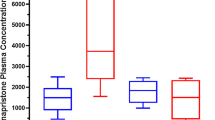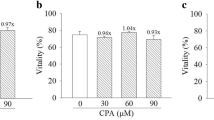Summary
The preclinical safety assessment of cyproterone acetate (CPA) with regard to liver tumorigenesis was based on tumorigenicity studies, which revealed no mutagenic potential. Recently, in vitro studies on the formation of adducts and the enhancement of DNA repair synthesis with CPA have been published. These results are not unique to CPA, and the role of adducts and increased DNA synthesis in mutagenesis is still not clear.
Dose-related hepatic toxicity has been reported with the prolonged use of CPA. An active surveillance study of patients taking long term CPA treatment has shown no correlation between the duration of CPA treatment and the prevalence of liver enzyme elevations. In a multicentre surveillance study of long term CPA use in 2506 patients included so far, not a single case of hepatocellular carcinoma has been observed. These findings do not support the theory of an elevated risk of hepatocellular carcinoma as a result of CPA treatment.
In conclusion, there have been no observations which could point to an increased risk of proliferative liver change as a result of CPA treatment.
Access this article
We’re sorry, something doesn't seem to be working properly.
Please try refreshing the page. If that doesn't work, please contact support so we can address the problem.
Similar content being viewed by others
References
Watanabe S, Yamasaki S, Tanae A, et al. Three cases of hepatocellular carcinoma among cyproterone users. Lancet 1994 Dec; 344: 1567–8
Rüdiger T, Beckmann J, Queißer W. Hepatocellular carcinoma after treatment with cyproterone acetate combined with ethinyloestradiol. Lancet 1995; 345: 452–3
Topinka J, Andrae U, Schwarz LR, et al. Cyproterone acetate generates DNA adducts in rat liver and in primary rat hepatocyte cultures. Carcinogenesis 1993; 14: 423–7
Neumann I, Thierau D, Andrae U, et al. Cyproterone acetate induces DNA damage in cultured rat hepatocytes and preferentially stimulates DNA synthesis in γ-glutamyltranspeptidasepositive cells. Carcinogenesis 1992; 13(3): 373–8
Hepatic reactions with cyproterone acetate (Cyprostat, Androcur). Curr Probl Pharmacovigilance 1995 Feb: 21: 1
Harris CC. Chemical and physical carcinogenesis: advances and perspectives for the 1990s. Cancer Res 1991; 51 Suppl: 5023S–44S
Werner S, Topinka J, Kunz S. Formation of hepatic DNA adducts by cyproterone acetate in various species. High levels are formed in human hepatocytes. Abstracts of the Fifth International Symposium on Biological Reactive Intermediates; 1995 Jan 4–8; Munich
Shimomura M, Higashi S, Mizimoto R. 32P-postlabelling analysis of DNA-adducts in rats during estrogen-induced hepatocarcinogenesis and effect of tamoxifen on DNA adduct level. Jpn J Cancer Res 1992; 83: 438–44
Jaggi W, Lutz WK, Schlatter C. Covalent binding of ethinylestradiol and estrone to rat liver DNA in vivo. Chem Biol Interact 1978; 23: 13–8
Ferser W, Reimann R, Kerdar RS, et al. DNA adduct formation and DNA repair synthesis of selected synthetic and endogenous steroid hormones in rat liver. Abstracts of the 2nd International Conference on Environmental Mutagens in Human Populations; 1995 Aug 20–25, Prague
Topinka J, Binkova B, Zhu HK, et al. DNA-damaging activity of the cyproterone acetate analogues chlormadinone acetate and megestrol acetate in rat liver. Carcinogenesis 1995; 167: 1483–7
Topinka J, Zhu HK, Binkova B, et al. Genotoxicity of the synthetic steroids cyproterone acetate (CPA), megestrol acetate (MGA) and chlormadinone acetate (CMA) in rat liver cells. Abstract of a poster presented at the 22nd Annual Meeting of the European Environmental Mutagen Society (EEMS); 1992 Aug 31–Sep 4; Berlin
Kerdar RS, Baumann A, Brudny-Kloppel M, et al. Identification of 3 alpha-hydroxy-cyproterone acetate as a metabolite of cyproterone acetate in the bile of female rats and the potential of this and other already known or putative metabolites to form DNA adducts in vitro. Carcinogenesis 1995; 16(8): 1835–41
ECETOC DNA and protein adducts: evaluation of their use in exposure monitoring and risk assessment. Brussels: ECETOC, ECETOC Monograph No. 13, 1989 Oct
Purchase IFH. Current knowledge of mechanisms of carcinogenicity: genotoxicity versus non-genotoxins. Hum Exp Toxicol 1994; 13: 17–28
Roberts JJ. The repair of DNA modified by cytotoxic, mutagenic and carcinogenic chemicals. Adv Radiat Biol 1978; 7: 211–436
Rasmussen RE, Painter RB. Radiation stimulated DNA synthesis in cultured mammalian cells. J Cell Biol 1966; 9: 11–9
Williams GM. Carcinogen-induced DNA repair in primary rat liver cell cultures; a possible screen for chemical carcinogenesis. Cancer Lett 1976; 1: 231–6
Williams GM, Laspia MF, Dunkel VC, et al. Reliability of the hepatocyte primary cultural DNA repair test in testing of coded carcinogens and noncarcinogens. Mutat Res 1982; 97: 359–70
Mitchell AD, Casciano DA, Meltz ML, et al. Unscheduled DNA synthesis test: a report of the U.S. Environmental Protection Agency Gene-Tox Program. Mutat Res 1983; 123: 363–410
Kasper P, Gerhard A, Kauffman G, et al. Further investigations into the genotoxicity of cyproterone acetate. Abstract of a poster presented at the 23rd Annual Meeting of the European Environmental Mutagen Society (EEMS). 1993 Sep 27–Oct 2; Barcelona
Topinka J, Zhu HK, Binkova B, et al. Studies on the genotoxicity of structural analogues of the synthetic progestin, cyproterone acetate (CPA) in rat liver. Naunyn Schmiedebergs Arch Pharmacol 1994; 349 Suppl.
Martelli A, Mattioli F, Fazio S, et al. DNA repair synthesis and DNA fragmentation in primary cultures of human and rat hepatocytes exposed to cyproterone acetate. Carcinogenesis 1995; 6(16): 1265–9
Fahrig R. General strategy for the assessment of genotoxicity. Mutat Res 1991; 252: 161–3
Lang R, Reimann R. Studies for a genotoxic potential of some endogenous and exogenous sex steroids. Communication: examination for the induction of gene mutations using the Ames Salmonella/microsomes test and the HGPRT test in V79 cells. Environ Mol Mutagen 1993; 21: 272–304
Reimann R, Kalweit S, Lang R. Studies for a genotoxic potential of some endogenous and exogenous sex steroids. II. Communication: examination for the induction of cytogenetic damage using the chromosomal aberration test on human lymphocytes in vitro and the mouse bone marrow micronucleus test. Environ Mol Mutagen 1993; 21: 304–39
Degen GH, Metzler M. Sex hormones and neoplasia: genotoxic effects in short-term assays. Arch Toxicol 1987; Suppl. 10: 264–78
WHO, IARC monographs on the evaluation of the carcinogenic risk to humans. Genetic and related effects: an updating of selected IARC monographs from volumes 1 to 42. Lyon: International Agency for Research in Cancer, 1987; Suppl. 6: 1–729
Weimar C. Untersuchungen von Cyproterone-Acetat und Tamoxifen auf mutagene Aktivität in Salmonella typhimurium in Platteninkörporationstests und Koinkubationstests mit primären Ratten-Hepatozyten [doctoral thesis]. Freiburg: University of Freiburg, 1994
Goodman DG, Maronpot RR, Newberne PM, et al. Proliferative and selected other lesions of the rats. In: Guides for toxicologic pathology STP/ARP/AFIP. Registry of toxicologic pathology for animals. Washington (DC): Armed Forces Institute of Pathology, 1994
Harada T, Maronpot RR, Morris RW, et al. Morphological and stereological characterization of hepatic foci of cellular alteration in control Fischer 344 rats. Toxicol Pathol 1989; 17 (4 Part 11): 579–93
Pitot HC. Altered hepatic foci: their role in murine hepatocarcinogenesis. Annu Rev Pharmacol Toxicol 1990; 30: 465–500
Faccini JM, Butler WR, Friedman JC, et al. IFSTP guidelines for the design and interpretation of the chronic rodent carcinogenicity bioassay. Exp Toxicol Pathol 1992; 44: 443–56
Oesterle D, Deml E. Promoting effect of polychlorinated biphenyls on development of enzyme-altered islands in livers of weanling and adult rats. J Cancer Res Clin Oncol 1983; 105: 141–7
Schuppler J, Damme J, Schulte-Hermann R. Assay of some endogenous and synthetic sex steroids for tumor-initiating activity in rat liver using Solt-Farber system. Carcinogenesis 1983; 4(2): 239–41
Deml E, Schwarz LR, Oesterle D. Initiation of enzyme-altered foci by the synthetic steroid cyproterone acetate in rat liver foci bioassay. Carcinogenesis 1993; 14(6): 1229–31
Cohen SM, Ellwein LB. Cell proliferation in carcinogenesis. Science 1990; 51: 1007–11
Schulte-Hermann R, Hoffmann V, Parzefall W, et al. Adaptive responses of rat liver to the gestagen and anti-androgen cyproterone acetate and other inducers: I. Induction of drug-metabolizing enzymes. Chem Biol Interact 1980; 31: 279–86
Schulte-Hermann R. Stimulation of liver growth and mixedfunction oxidase by α-hexachlorocyclohexane: separation of inductive pathways. In: Ullrich V, Roots I, Hidlebrandt A, et al, editors. Microsomes and drug oxidations. Oxford: Pergamon Press, 1977: 559–67
Parzefall W, Monschau P, Schulte-Hermann R. Induction by cyproterone acetate of DNA-synthesis and mitosis in primary cultures of adult rat hepatocytes in serum-free medium. Arch Toxicol 1989; 63: 456–61
Parzefall W, Erber E, Sedivy R, et al. Testing for induction of DNA-synthesis in human hepatocyte primary cultures by rat liver promoters. Cancer Res 1991; 51: 1143–7
Schulte-Hermann R, Ochs H, Bursch W, et al. Quantitative structure-activity studies on effects of sixteen different steroids on growth and monooxygenases of rat liver. Cancer Res 1988; 48: 2462–8
Schuppler J, Gunzel P. Liver tumors and steroid hormones in rats and mice. Arch Toxicol 1979; Suppl. 2: 181–95
Capel-Edwards K, Hall DE, Fellowes KP, et al. Long-term administration of progesterone to the female beagle dog. Toxicol Appl Pharmacol 1973; 24: 474–88
Geil RG, Lamar JK. FDA studies of estrogen, progestogens, and estrogen/progestogen combinations in the dog and monkey. J Toxicol Environ Health 1977; 3: 179–93
Fitzgerald J, de la Iglesia F, Goldenthal EI. Ten year oral toxicity study with norlestrin in rhesus monkeys. J Toxicol Environ Health 1982; 10: 879–96
Gerok W, Kluge F, Gerok W. Leberschäden durch Fremdstoffe. In: Hepatologie. Munich: Urban u. Schwarzenberg, 1987: 369–79
Heinemann LAJ, Will-Shahab L. Active surveillance study on patients treated with CPA long-term. The SEHOST project. Berlin: Research Report ZEG, 20 June 1995
Baum JK, Holtz F, Bookstein JJ, et al. Possible association between benign hepatomas and oral contraceptives. Lancet 1973; 2: 926–9
Rabe T, Feldmann K, Grunwald G, et al. Liver tumours in women on oral contraceptives. Lancet 1994; 344: 1568–9
Rabe T, Kattermann R. Lebertumoren unter der Einnahme von oralen hormonalen Kontrazeptiva [doctoral thesis]. Heidelberg: University of Heidelberg, 1988
Ohri SK, Caer JAR, Keane PF. Hepatocellular carcinoma and treatment with cyproterone acetate. Br Med Urol 1991; 67: 213–21
Kattan J, Spatz A, Culine S, et al. Hepatocellular carcinoma during hormone therapy for prostatic cancer. Am J Clin Oncol Cancer Clin Ther 1994; 17: 390–2
Thomas DB. Exogenous steroid hormones and hepatocellular carcinoma. In: Tabor E, DiBisceglie AM, Purcell RH, editors. Etiology, pathology and treatment of hepatocellular carcinoma in North America. Advances in Applied Biotechnology Series, Vol 13. Houston: Gulf Printing Co., 1991: 77–89
World Health Organization. Oral contraceptives and neoplasia. Report of a WHO Scientific Group. WHO Technical Report Series 817, Geneva, 1992: 22–5
Vana J, Murphy GP, Aronoff BL, et al. Primary liver tumors and oral contraceptives: results of a survey. JAMA 1977; 238: 2154–8
Nime F, Pckren JW, Vana J, et al. The histology of liver tumors in oral contraceptive users observed during a national survey by the American College of Surgeons. Commission on Cancer. Cancer 1979; 44: 1481–9
The MILTS Collaborative Research Team: Heinemenn L, Thomas DB, Möhner M. Multicentre international liver tumour study. Research protocol of the case control study on hepatocellular cancer. Submitted for publication
Muir C, Waterhouse J, Powell J, et al. Cancer incidence in five continents. Lyon: International Agency for Research in Cancer, 1987
Nischan P, Heinemenn L, Möhner S. Trends of hepatocellular cancer incidence and sales data on CPA, German. Internal research report. Berlin: ZEG, 1994
Author information
Authors and Affiliations
Rights and permissions
About this article
Cite this article
Rabe, T., Feldmann, K., Heinemann, L. et al. Cyproterone Acetate. Drug-Safety 14, 25–38 (1996). https://doi.org/10.2165/00002018-199614010-00004
Published:
Issue Date:
DOI: https://doi.org/10.2165/00002018-199614010-00004




